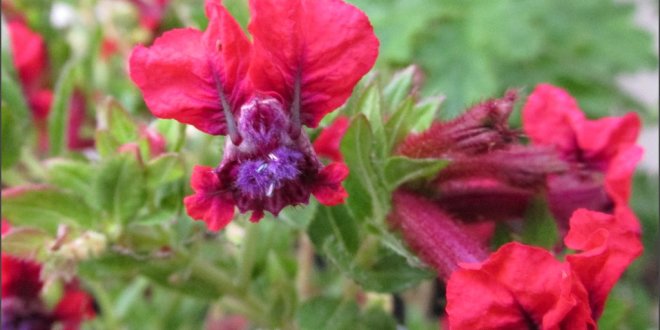Many gardeners have learned the value of Cuphea for summer long flowers. We value them not only for the small, attractive flowers, but also for the hummingbirds, butterflies, and nectar-feeding insects that swarm around them. Aka Bat-Face Cuphea, St. Peter’s Plant, Tiny Mice, Bunny Ears, Cuphea llavea.
Cuphea is a family of plants containing about 115 species according to the GRIN website. Members of the Lythraceae or loosestrife family, these woody subshrubs hail mostly from tropical regions of Central America and Mexico; however, some are native to North America.
As a group, they freeze to the ground in winter in my Zone 9 garden. Every spring most of them return reliably. Most species begin blooming almost as soon as they emerge from their winter dormancy. Others, however, initiate flowers during the short days of autumn.
Details
Family: Lythraceae (ly-THRAY-see-ee) (Info)
Genus: Cuphea (KYOO-fee-uh) (Info)
Species: llavea (LAH-vay-uh) (Info)
Cultivar: Flamenco Red
Synonym:Cuphea barbigera
Synonym:Parsonia llavea
Category:
Annuals
Tropicals and Tender Perennials
Height:
18-24 in. (45-60 cm)
Spacing:
24-36 in. (60-90 cm)
Hardiness:
USDA Zone 8a: to -12.2 °C (10 °F)
USDA Zone 8b: to -9.4 °C (15 °F)
USDA Zone 9a: to -6.6 °C (20 °F)
USDA Zone 9b: to -3.8 °C (25 °F)
USDA Zone 10a: to -1.1 °C (30 °F)
USDA Zone 10b: to 1.7 °C (35 °F)
USDA Zone 11: above 4.5 °C (40 °F)
Sun Exposure:
Sun to Partial Shade
Danger:
Unknown – Tell us
Bloom Color:
Red
Dark Purple/Black
Bloom Time:
Late Spring/Early Summer
Mid Summer
Late Summer/Early Fall
Blooms repeatedly
Foliage:
Evergreen
Other details:
This plant is attractive to bees, butterflies and/or birds
Drought-tolerant; suitable for xeriscaping
Average Water Needs; Water regularly; do not overwater
Soil pH requirements:
6.1 to 6.5 (mildly acidic)
6.6 to 7.5 (neutral)
7.6 to 7.8 (mildly alkaline)
Patent Information:
Non-patented
Propagation Methods:
From softwood cuttings
Seed Collecting:
Collect seedhead/pod when flowers fade; allow to dry
Read more: http://davesgarden.com/guides/pf/go/2033/#ixzz3GozOsiOV








